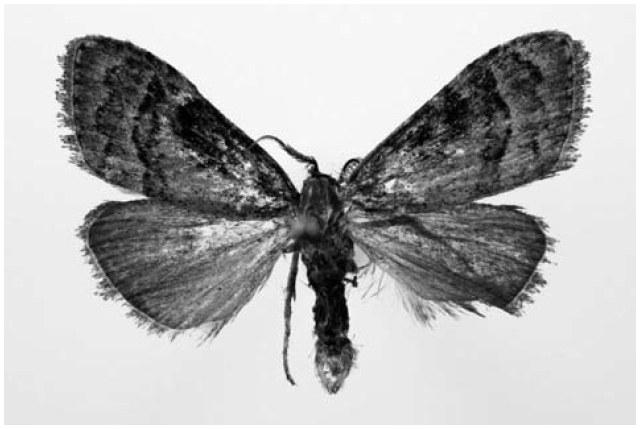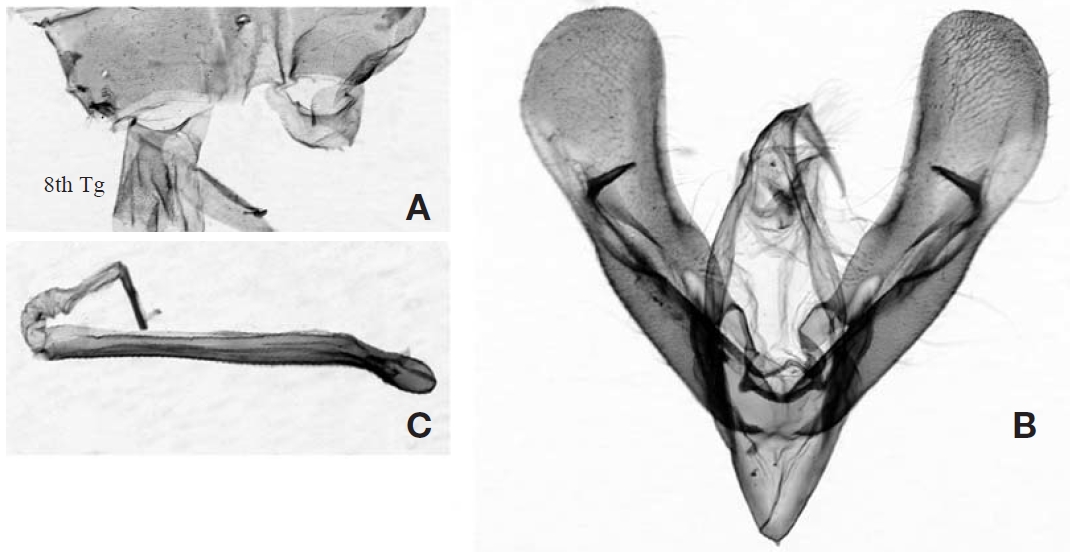



The Nolidae are small to medium sized moths and are esti-mated about 1,400 species in 308 genera. They occur world-wide, but primarily palaeotropical in distribution. The synapo-morphies of the Nolidae include the following characters: the dorsally broadened postspiracular bar at the base of the abdomen, the easily detached tegulae and patagia, an elon-gate retinaculum of male wing, and the ventrally directed M4 male genital muscle (Kitching and Rawlins, 1999).
The genus
Up to now, a total of 19 species in three genera of Nolidae are recognized in Korea (Oh, 2001; Choi, 2006). Among them 6 species of
Order Lepidoptera Linnaeus, 1758
Family Nolidae Hampson, 1894
Subfamily Nolinae Hampson, 1894
Genus Roeselia Hubner, 1825
1*Roeselia triangulalis (Leech) (Figs. 1, 2)
Roeselia triangulalis: Matsumura, 1930: 94.
Meganola triangulalis: Holloway, 2003: 26.
Material examined. Korea: [JJ] 1♂, Seoguipo-si, Namwon-eup, Silye-ri, Mt. Halla-san, N33? 19′56.7′′, E126? 36′25.7′′,499 m, 11 Jun 2009 (MNU); 1♂, Seoguipo-si, Namwon-eup, Harye-ri, Mt. Halla-san, N33? 18′56.8′′, E126? 37′09.4′′, 264 m, 4 May 2010 (MNU).
Diagnosis. This species can be distinguished by the bipecti-nate male antennae, broad frons with dark ochreous and whitish scales, long labial palpi with distally dilated second segment, and costally dark brownish scales and the dark brownish postmedial line and subtermen of forewing. This species is similar to
wingspan and the rounded postmedial line without costal pro-jection of forewing. The male genitalia can be diagnosed by the short uncus, with hairy socii, the long tegumen twice to the tegumen in length, the long triangular saccus, the slender membranous valva with a strong spine-like harpe and slender aedeagus with a long spinular cornutus. The male genitalia are similar to those of
Description (Fig.1 ). Wingspan 20-21 mm. Antennae in male bipectinate; frons broad, trapezoidal, mixed with yellowish white and dark ochreous scales; labial palpi long, almost twice the eye diameter, projected forward, 2nd segment dis-tally dilated. Body and legs covered with whitish scales. Forewing ground color light grayish, costa basal part covered with blackish scales; postmedial line blackish, medially slightly projected outward; termen dark brownish with an undulating blackish line. Hindwing ground color light grayish, paler at basal part.
Male abdomen and genitalia (Fig.2 A-C): Eighth tergite posteriorly sharp edges. Uncus short, slender, basally tapering; socii hairy; tegumen long, twice the length of vinculum; juxta simple with a thin sclerotized line; saccus long, triangular.Valva long, distally expanded; costa slender, weakly sclero-tized; sacculus slender with a strong spine-like harpe. Aedea-gus slim; vesica long, tubular with a long rod-like cornutus.
Female genitalia: Papillae anales simple, roudned. Anterior apophyses long, twice of the posterior apophyses. Antrum U-shaped and membranous. Ductus bursae long, narrow, twisted anteriorly. Corpus bursa large, ovate, membranous,with a lip-shaped signum (Holloway, 2003).
Distribution. Korea, Japan, Taiwan, N. India, Sundaland.
Biology. Flying period of moths is from May to June in southern Korea.
Korean name: 1*남방삼각무늬혹나방 (신칭)

